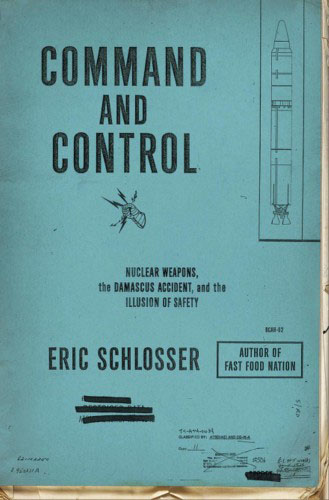As a newly commissioned lieutenant in the mid-1980s, with the Cold War still ‘raging’, I sat in a classroom at the School of Military Engineering and was drilled on ‘nuclear target analysis’ as part of the ‘offensive module’ of the nuclear, biological and chemical defence officers’ course. I recall having an aerial photograph of a city placed before me and then told of the level of destruction required. Whizzing through calculations with logarithmic tables and my slide rule, I answered: “2.4 kilotons at a 450 foot burst height!” Looking back now I realise how obscene this training was.
Command and Control is a disquieting but riveting book. Written with the vibrancy of a first-rate thriller, it interweaves the minute-by-minute story of the struggle to prevent the explosion of a Titan II ballistic missile carrying the most powerful thermonuclear warhead ever built by the United States, with a historical narrative that spans more than 70 years.
Award winning investigative journalist, Eric Schlosser, tells the story of the urgent effort by American scientists, policymakers, and military officers to ensure that tens of thousands of nuclear weapons located around the globe could not be stolen, sabotaged, used without permission, or detonated inadvertently. Drawing on recently declassified documents and interviews with men who designed and routinely handled nuclear weapons, Command and Control digs deep to uncover secrets about the development and management of the United States’ nuclear arsenal. A ground-breaking account of technological challenges, accidents, near-misses, and extraordinary heroism, Schlosser reveals how the combination of human fallibility and technological complexity still poses a grave risk to mankind.
Schlosser examines problems with the command and control systems that in theory were supposed to provide presidents with the information they would need to make the decision on whether the United States should retaliate against a Soviet strike. Constructing the complex systems needed for this task – linking radar sites and monitor stations around the world into a single network for analysis and control – was well beyond the technological capacity of American engineers for much of the Cold War, but they did the best they could. The system they created, which led among other things to the technology that gave us the Internet, was not only subject to glitches and crashes, it was also too brittle to survive any serious Soviet attack, too inflexible to give United States presidents good choices at what would have been the most critical moments in world history, and too subject to error to be relied on. At various points, flocks of birds, sunshine reflecting off clouds and the rising moon over Norway set off alarm bells. One false alert went high enough up the command chain that a general woke the national security adviser, Zbigniew Brzezinski, in the middle of the night; as he waited for confirmation that Soviet missiles were on their way before calling President Carter, Brzezinski decided to not wake his wife and let her die in peace.
Schlosser also provides a detailed treatment of the bitter inter-service rivalries that affected the development of America’s nuclear systems and doctrine. He also looks at the Cold War from a new perspective, offering history from the ground up, telling the stories of bomber pilots, missile commanders, maintenance crews, and other ordinary servicemen who risked their lives to avert a nuclear tragedy.
And yes, it is true so far that “none of the roughly 70,000 nuclear weapons built by the US since 1945 has ever detonated inadvertently or without proper authorisation”. But the United States is an extremely rich, technologically sophisticated country, and as the inventor of nuclear weapons in the first place, the one furthest advanced in developing “the organisational skills and safety culture necessary to manage them”. And even it, as Schlosser has shown, has only narrowly avoided nuclear disaster. “Other nuclear weapon armed countries, with less hard-earned experience, may not be as fortunate”, Schlosser laments.
The United States still has an arsenal of 4650 nuclear weapons, aimed at Russia, China, North Korea, Syria and Iran, with potential to swivel round at other enemies as they pop up. Russia has about 1500 ‘strategic’ – i.e. long-range, intercontinental – missiles and may be 2000 ‘tactical’ ones, which are the shorter-range weapons for use in what used to be called ‘the European theatre’. The United Kingdom has some, France has some, India and Pakistan aim theirs at each other, Israel keeps its collection secret and China hides its in ‘an underground Great Wall’. North Korea and Iran are working feverishly to develop their capabilities. Across the world in the early 21st century, nuclear weapons have become ‘a symbol of power and source of national pride’. But the threats they pose are as grave to the countries that possess them as they are to everybody else.
The human race was smart enough to build these weapons. So far, we appear to lack the intelligence needed either to get rid of them or to store them safely. Schlosser’s readers will be struck by how frequently the people he cites attribute the absence of accidental explosions and nuclear war to divine intervention or sheer luck rather than to human wisdom and skill. Whatever was responsible, we will clearly need more of it in the years to come.
Schlosser, it is obvious, has done a stupendous amount of research, talking to everybody, chasing up every note and file that can be read, and with 92 pages of notes at the end of the book to prove it – fascinating, a masterclass in itself as to how this sort of investigative work is done.
Audacious, gripping, and unforgettable, Command and Control is a tour de force of investigative journalism, an eye-opening look at the dangers of America’s nuclear age and highly recommended.

Contact Marcus Fielding about this article.






